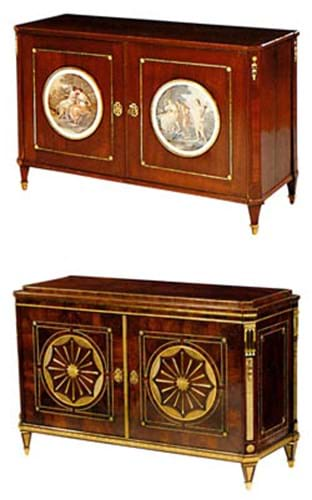
Remodelling and embellishment to improve the commercial appeal ot the two commodes involved the addition of plinth tops and the metamorphosis of the central roundels from frames set with neoclassical prints to sophisticated ormolu sunbursts.
With only the sabots, escutcheons and flowerheads to the front remaining from the original design, they now purport to be Russian productions from the turn of the 19th century, as pictured here at the bottom.
It was the 'restorer's' decision to preserve documentary evidence to the carcasses that led Bonhams' team of specialists to uncover their true history.
When cataloguing the apparently important commodes for the sale of the Owston collection in Sydney in late June, the presence of the brand of a crowned TT for the Princes of Thurn and Taxis caused them to reach for Sotheby's mammoth sale catalogue of 1993 where they found lot 33, a pair of Austrian mahogany side cabinets of very similar dimensions sold for DM59,800.
Remarkably, the 1993 catalogue detailed pencil inscriptions to the reverse identical to those on the Owston commodes including (to one) the inventory number L170 for Schloss Leitomisehl, Bohemia, where they resided in 1890, and (to both) the code ST.E 15549 for Schloss St Emmeran, Regensburg.
Bonhams' admirable detective work concluded that the two pairs of commodes were one and the same, although sometime between 1993 and 2006, when they were acquired by their Australian vendor from the Pimlico Road dealer John Hobbs, they had been extensively remodelled.
It is not known how the commodes were described when sold in 2006 but the ATG understands a six-figure sterling price changed hands.
Bonhams, who considered them seriously compromised as pieces of genuine antique furniture, chose to catalogue them simply as "a pair of mahogany and ormolu mounted commodes in the Russian style, the carcass late 18th/early 19th century, altered and remounted after 1993."
Estimated at Aus$40,000-60,000, they got away at Aus$35,000 (£20,600).
It was back in 2008 that allegations surfaced in The Sunday Times that London dealer and former BADA member John Hobbs had sold as genuine antiques, furniture that was largely the creation of his Kent-based restorer Dennis Buggins. Mr Buggins had turned 'whistleblower' following a bitter financial dispute with his long-term employers.
At the time, he said he was considering setting up a website to make available surviving records of every substantially altered or fabricated item that passed through his workshop over the past 20 years. He now lives in Turkey.
These Owston commodes bear some comparison with the pair of commodes with a John Hobbs provenance that appeared in a New York sale in June 2008. Catalogued as "a fine pair of German neoclassical ormolu-mounted mahogany commodes c.1800" and estimated at $200,000-300,000, they had represented something of a puzzle to Sotheby's specialists who speculated that the commodes might have been made in Berlin for the Russian market.
However Mr Buggins, a pioneer in the restoration of antique furniture using old materials whose speciality was the replication of ormolu work, said he had made them between 1993 and 1994 for John Hobbs from old wardrobes and provided a detailed worksheet to support his claims. Sotheby's later concluded they were fakes and withdrew them from sale.
By Roland Arkell




